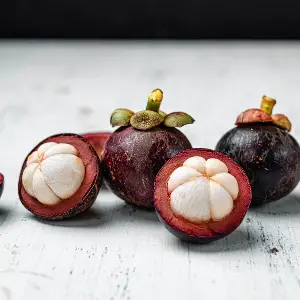
Said to taste like a combination of peach, strawberry and lychee, Mangosteens are fruits which are native to SouthEast Asia and India.
In recent years, the trees have started to be grown in Florida as well.
Not only do they taste like a combination of a few different fruits but the taste is also meant to be sweet and sour.
A bit like a bag of sweets from Haribo- or not!
To me, with their thick rinds, they most remind me of a horse chestnut.
But whilst the rind of a horse chestnut is green, the rind of a Mangosteen is dark purple.
In contrast to the dark brown of a conker.
And when opened the Mangosteen reveals a set of vivid white seeds, each like a segment from a small tangerine.
But regardless of how they look and taste to us.
The key question is, can our dogs eat them?
What is the nutrition in Mangosteens?
Like many fruits, mangosteen are relatively low in calories and fat but they offer truck loads of nutrients.
As far as vitamins go, mangosteens are high in vitamin C, and vitamins B1, B2 and B9.
When we look at the minerals that this fruit is rich in we can see that manganese, copper and magnesium top the list.
But just providing a long list of vitamins and minerals which might or might not be beneficial to your dog only takes you so far.
And in the next section, I want to show how these nutrients can help your dog.
Why are Mangosteens good for dogs?
It has been drilled into us from a young age just how healthy fruit is.
But is it the same for our dogs?
Whether or not dogs would eat fruit without the intervention of humans is open to question but what is clear is that the vitamins and minerals found in mangosteens.
Vitamin C is an interesting vitamin as far as our dogs are concerned.
Because it is a vitamin that dogs actually make in their own liver.
However, an additional boost of vitamin C won’t harm them.
And adding vitamin C to the diet of any dog that is stressed physically or emotionally could really help them.
Anxiety and tiredness inhibit the ability of a dog to synthesise its own vitamin C.
B vitamins are crucial to a dog’s health in a few different ways.
As you may or may not know, there are 12 different B vitamins and each has a very specific role to play in the health of your dog.
To keep things brief, B vitamins support metabolism and keeping individual cells within the body healthy.
Moving onto the minerals, the manganese will help a dog have strong tissues between their bones.
Copper helps to support a healthy nervous system.
And finally magnesium also supports the nervous system as well as helping with energy production.
So is there any way in which mangosteens are bad for dogs?
Let’s find out shall we?
Why are Mangosteens bad for dogs?
There really isn’t anything bad about dogs eating Mangosteens unless I really wanted to create a fuss.
Fruits are high in sugar and so they should only be given in small amounts to dogs or very occasionally to them.
If your dog eats too many of them in one sitting then it might cause them to become a bit constipated because they have got quite a lot of fibre in them
Mangosteens do have some disadvantages but these don’t relate to how healthy they are to eat.
It is related to how difficult they are to get hold of.
But more on that later.
Can dogs eat a Mangosteen rind?
The rinds or skins of most vegetables and fruits are edible; it is just that they tend to be much tougher and more bitter than the flesh.
And there is a good reason for this.
The skin or rind of any fruit and vegetable is where most of the nutrients are stored.
As one example the skins of fresh fruit contain up to 30% more fibre than the flesh of them.
But that doesn’t let your dog off the hook yet.
The rind of a mangosteen is particularly tough even as far as fruits go.
And so although the rind might not be toxic, it might be a potential choking hazard for smaller dogs or dogs who just can’t be bothered to chew their food.
So go ahead and feed it to your dog.
Just cut it into small pieces and remember to rinse it with water first just in case there are any nasty chemicals lurking on the skin.
How much Mangosteen should I feed my dog?
Your dog should be getting enough calories and nutrients from its main meals.
Anything else that you feed to them should be given in very limited quantities, including tropical fruits such as these.
The flesh of a mangosteen is divided into satsuma type segments and so realistically you are looking at giving your dog about one or two of these segments.
And the reason for not giving your dog any more isn’t because to do so would be unhealthy, it is because mangosteens in the U.S. are hard to come by and expensive.
And that leads me nicely into the next few sections.
In which I will discuss the price and availability of mangosteens.
Can I buy fresh Mangosteens?
You will be hard pressed to find fresh mangosteen in your local supermarket.
Having looked on a few websites they don’t seem to be available.
Although of course, you can buy anything on Amazon.
Things may be different in Florida because that is a location where mangosteens are grown.
That leaves you with two options-buying from a specialist fruit seller online or visiting your local Asian Market and hoping that they have some fresh ones available.
The specialist fruit sellers that I looked at online were based in Florida and weren’t selling mangosteen now because they weren’t in season.
The season runs from May-September.
And these are an expensive fruit and a 4 lb box of mangosteen can cost you around $137.
But if you are desperate to add mangosteen to your dog’s diet, the fruit comes in different forms- cans, powder and capsules.
Can dogs eat canned mangosteen?
Although up until this point I have been very positive about the positive effects that mangosteen can have on your dog, the canned variety is where I draw the line.
And it is nothing against mangosteen.
You shouldn’t feed your dog any canned fruit.
And this is because in order to keep a mangosteen “fresh” it sits in syrup.
And syrup is just a thick sugar water increasing the sugar content of the fruit dramatically.
To reiterate, steer clear of canned mangosteen.
But don’t panic, we still have other options.
Can dogs eat Mangosteen powder or capsules?
Although not designed to cater to the needs of dog owners, mangosteen powder or capsules can be bought as a health supplement.
And there’s no reason to not use these with your dog as the only ingredients that the powder or capsules contain are mangosteen.
None of them contain any additives or preservatives.
Just remember that they are designed to be consumed by humans.
Which means that you need to give it to your dog in small amounts.
I’m talking about teaspoons here!
What are good alternatives for Mangosteens?
If you like what you read about this tropical fruit but you can’t find any or are unwilling to pay so much money for it, then there are alternatives.
One of the strongest health claims that mangosteen has but which we haven’t talked about is that it contains lots of antioxidants.
Antioxidants are powerful substances because of how they help the body fight disease.
And part of the reason that you will find such a high concentration of antioxidants in this fruit is because it is dark purple in colour.
It doesn’t hold true for every fruit or vegetable but the darker the colour of a fruit or vegetable, the more nutrients it contains.
And purple fruits and vegetables are powerhouses.
Just think blueberries, red cabbage (it’s purple) or purple cauliflower.
All of these alternatives are dog friendly, more available than mangosteen and most importantly price wise they are far cheaper.
Photo credits
¹ Photo by Art Rachen on Unsplash





